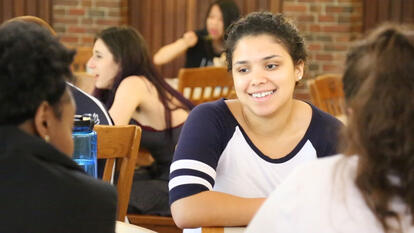
Creating Community While Cooking Takoyaki
As I entered the second floor Freeman kitchen, Japanese language assistant Yurie Moriwaki, better known as Moriwaki-sensei, rushed over and began giving me instructions for cooking takoyaki. I had never seen the battered and fried balls of octopus before, let alone eaten them. But I quickly began chopping octopus and discussing my class schedule in butchered Japanese to a fourth-year, much more fluent, resident of the College’s Japanese language corridor. As more people arrived, the room filled with the sounds of Japanese exclamatory expressions and casual speech—and sizzling food. I connected with people I have taken Japanese classes with (this is my second year) but had never spoken the language to outside of practicing prewritten dialogue. The room grew livelier, busier, and homier throughout the evening.
Japanese students are not the only ones who have an opportunity to live in a language-immersive community at Wellesley. Spanish speakers may choose to live in Casa Cervantes, and French speakers can opt to live in the French House; all other language corridors, which include Italian, German, Russian, Mandarin, Japanese, Korean, Arabic, and Hindi/Urdu, are now in Freeman. In these living spaces, Wellesley students can experience language immersion without having to take international flights.
“Why not take advantage?” says Japanese language corridor resident Leslie Blas ’24, who is in her second year of learning Japanese. Initially drawn to the language because of the opportunity to study abroad and her interest in Japanese dramas and anime, she has now found community in the Japanese corridor.
The members of French House are genuinely close. They know whatever is going on in each other’s lives.
Hyunsoo Nam ’25
The students living in these spaces love learning languages. In addition to Japanese, Blas speaks Spanish and English. Hyunsoo Nam ’25, a French House resident, is currently taking three language classes: advanced French, intermediate Latin, and introductory ancient Greek. Nam finds that all residents have an “interest in francophone culture” even if they’re not French majors. They watch movies and listen to music in French. Even one of the resident’s cats, the French House mascot, is named Pamplemousse, which means grapefruit in French. “The members of French House are genuinely close,” Nam says. “They know whatever is going on in each other’s lives. It’s very nice.”
Students are expected to speak and practice their target language in these living communities. Learning is an everyday occurrence, making the effort seem casual; for example, they might chat in Japanese while doing homework in the common room.
While classes provide cultural lessons, the language communities focus on experiential learning. In the Japanese corridor, for example, cultural events include movies, origami, cooking, tea time, Japanese drama, karaoke, and study nights. All the activities are open to the other students of the Freeman Hall East Asian language corridors and to those learning the language outside of the living community.
These events give the students chances to access activities that are commonplace in their target language’s home country and to learn words and sayings from each other and the native-speaking language assistants that do not appear in the textbook. The weekly events are accessible opportunities for students to learn more natural expressions as well as essential cultural knowledge.
Language assistants provide firsthand cultural knowledge, and they cultivate an environment where trying and failing are embraced as necessary for the learning process. Students speak in the target language and help their peers do so as well. “It’s really nice to have someone correct my grammar and speaking,” says Blas.



